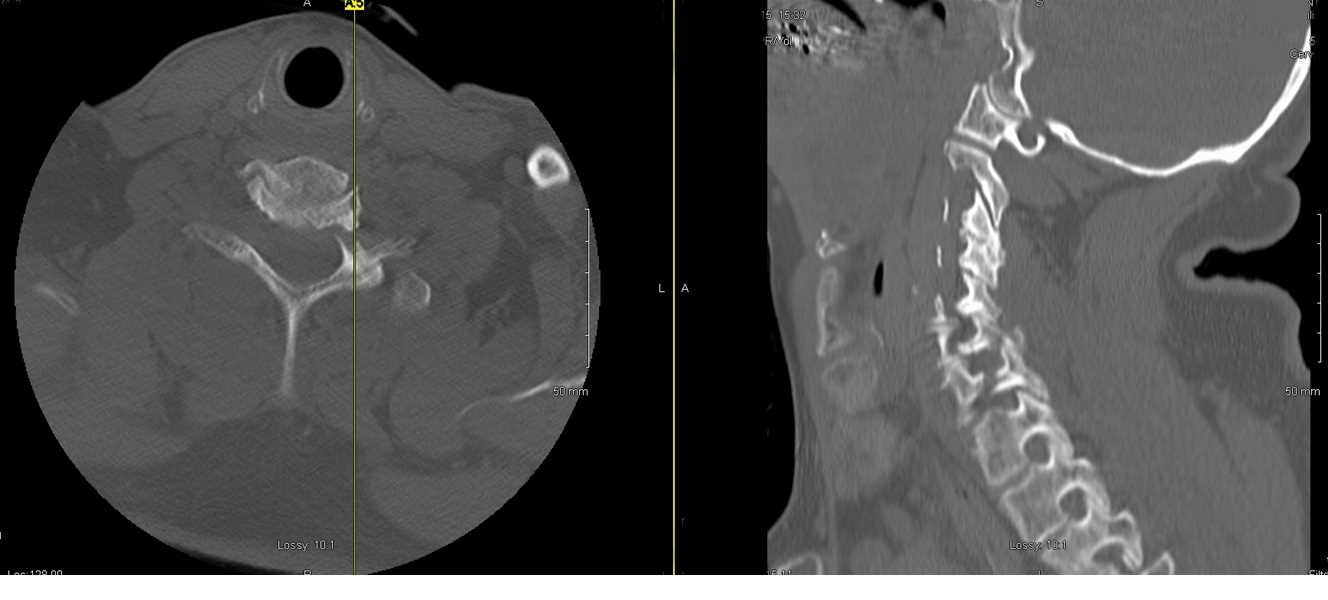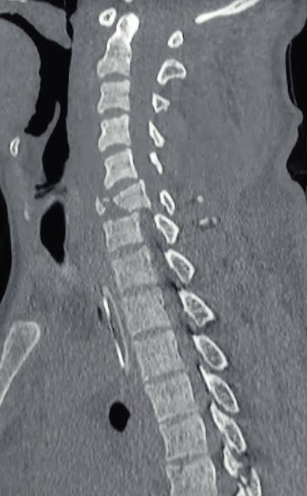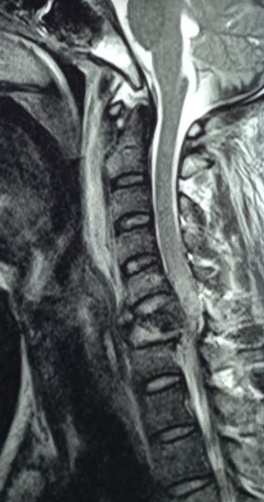[1]
van Eck CF, Fourman MS, Abtahi AM, Alarcon L, Donaldson WF, Lee JY. Risk Factors for Failure of Nonoperative Treatment for Unilateral Cervical Facet Fractures. Asian spine journal. 2017 Jun:11(3):356-364. doi: 10.4184/asj.2017.11.3.356. Epub 2017 Jun 15
[PubMed PMID: 28670403]
[2]
Dhillon CS, Jakkan MS, Dwivedi R, Medagam NR, Jindal P, Ega S. Outcomes of Unstable Subaxial Cervical Spine Fractures Managed by Posteroanterior Stabilization and Fusion. Asian spine journal. 2018 Jun:12(3):416-422. doi: 10.4184/asj.2018.12.3.416. Epub 2018 Jun 4
[PubMed PMID: 29879767]
[3]
Daniel RT, Hussain MM, Klocke N, Yandamuri SS, Bobinski L, Duff JM, Bucklen BS. Biomechanical Assessment of Stabilization of Simulated Type II Odontoid Fracture with Case Study. Asian spine journal. 2017 Feb:11(1):15-23. doi: 10.4184/asj.2017.11.1.15. Epub 2017 Feb 17
[PubMed PMID: 28243364]
Level 3 (low-level) evidence
[4]
Modi JV,Soman SM,Dalal S, Traumatic Cervical Spondyloptosis of the Subaxial Cervical Spine: A Case Series with a Literature Review and a New Classification. Asian spine journal. 2016 Dec;
[PubMed PMID: 27994781]
Level 2 (mid-level) evidence
[5]
Beckmann NM, Chinapuvvula NR, Zhang X, West OC. Epidemiology and Imaging Classification of Pediatric Cervical Spine Injuries: 12-Year Experience at a Level 1 Trauma Center. AJR. American journal of roentgenology. 2020 Jun:214(6):1359-1368. doi: 10.2214/AJR.19.22095. Epub 2020 Mar 31
[PubMed PMID: 32228329]
[6]
Fiedler N, Spiegl UJA, Jarvers JS, Josten C, Heyde CE, Osterhoff G. Epidemiology and management of atlas fractures. European spine journal : official publication of the European Spine Society, the European Spinal Deformity Society, and the European Section of the Cervical Spine Research Society. 2020 Oct:29(10):2477-2483. doi: 10.1007/s00586-020-06317-7. Epub 2020 Jan 30
[PubMed PMID: 32002697]
[7]
Fehlings MG, Tetreault L, Nater A, Choma T, Harrop J, Mroz T, Santaguida C, Smith JS. The Aging of the Global Population: The Changing Epidemiology of Disease and Spinal Disorders. Neurosurgery. 2015 Oct:77 Suppl 4():S1-5. doi: 10.1227/NEU.0000000000000953. Epub
[PubMed PMID: 26378347]
[8]
Hussain M, Javed G. Diagnostic accuracy of clinical examination in cervical spine injuries in awake and alert blunt trauma patients. Asian spine journal. 2011 Mar:5(1):10-4. doi: 10.4184/asj.2011.5.1.10. Epub 2011 Mar 2
[PubMed PMID: 21386941]
[9]
Girotto D, Ledić D, Strenja-Linić I, Peharec S, Grubesić A. Clinical and medicolegal characteristics of neck injuries. Collegium antropologicum. 2011 Sep:35 Suppl 2():187-90
[PubMed PMID: 22220432]
[10]
Van Goethem JW, Maes M, Ozsarlak O, van den Hauwe L, Parizel PM. Imaging in spinal trauma. European radiology. 2005 Mar:15(3):582-90
[PubMed PMID: 15696292]
[11]
Kopczyński S, Derenda M, Kowalina I, Siwiecki T. [Surgical treatment after cervical spine and spinal cord injuries of the C3-C7 level]. Neurologia i neurochirurgia polska. 2002 Jul-Aug:36(4):669-82
[PubMed PMID: 12418133]
[12]
Veres R, Pentelényi T, Turóczy L, Zsolczai S, Major J, Kenéz J. [Early experience with the use of the Halo device in the treatment of damage to the cervical spine]. Magyar traumatologia, orthopaedia es helyreallito sebeszet. 1989:32(1):15-23
[PubMed PMID: 2566717]
[13]
Smith RM, Bhandutia AK, Jauregui JJ, Shasti M, Ludwig SC. Atlas Fractures: Diagnosis, Current Treatment Recommendations, and Implications for Elderly Patients. Clinical spine surgery. 2018 Aug:31(7):278-284. doi: 10.1097/BSD.0000000000000631. Epub
[PubMed PMID: 29620588]
[14]
Stein DM, Knight WA 4th. Emergency Neurological Life Support: Traumatic Spine Injury. Neurocritical care. 2017 Sep:27(Suppl 1):170-180. doi: 10.1007/s12028-017-0462-z. Epub
[PubMed PMID: 28913694]
[15]
Poorman GW, Segreto FA, Beaubrun BM, Jalai CM, Horn SR, Bortz CA, Diebo BG, Vira S, Bono OJ, DE LA Garza-Ramos R, Moon JY, Wang C, Hirsch BP, Tishelman JC, Zhou PL, Gerling M, Passias PG. Traumatic Fracture of the Pediatric Cervical Spine: Etiology, Epidemiology, Concurrent Injuries, and an Analysis of Perioperative Outcomes Using the Kids' Inpatient Database. International journal of spine surgery. 2019 Jan:13(1):68-78. doi: 10.14444/6009. Epub 2019 Feb 22
[PubMed PMID: 30805288]
[16]
Ye IB, Girdler SJ, Cheung ZB, White SJ, Ranson WA, Cho SK. Risk Factors Associated with 30-Day Mortality After Open Reduction and Internal Fixation of Vertebral Fractures. World neurosurgery. 2019 May:125():e1069-e1073. doi: 10.1016/j.wneu.2019.01.247. Epub 2019 Feb 18
[PubMed PMID: 30790742]



